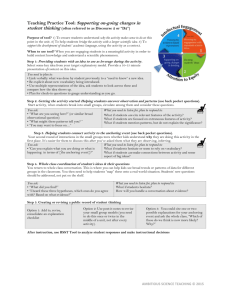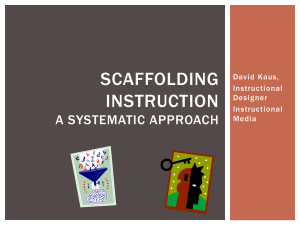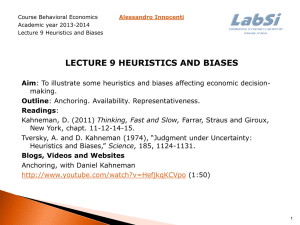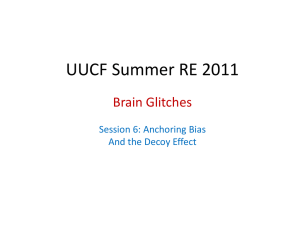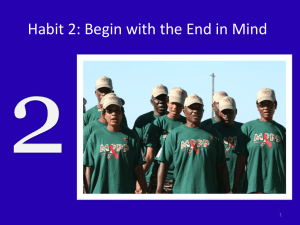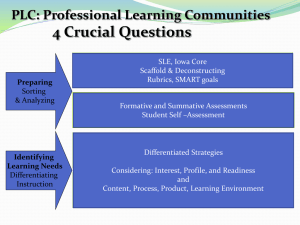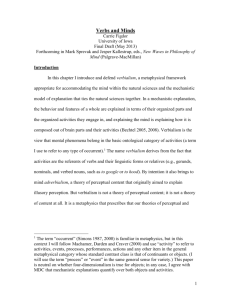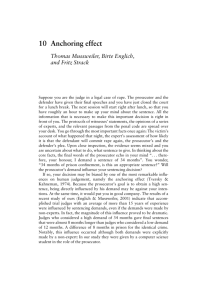Anchoring & Adjustment Bias
advertisement
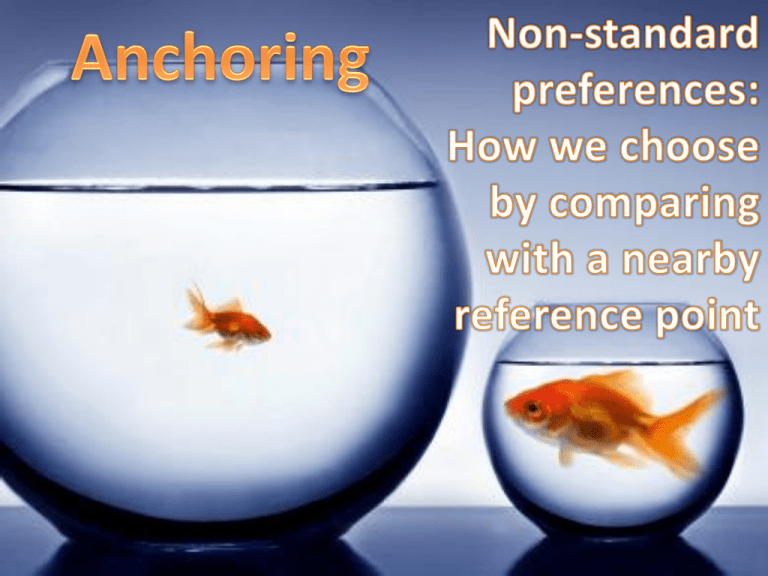
Reading • Predictably Irrational – Chapter 1 The Truth about Relativity – Chapter 2 The Fallacy of Supply and Demand • Nudge, “Rules of Thumb” in Chapter 1 • Thinking, Fast and Slow, Chapter 11 (“Anchors”) Willingness to pay • Standard economics assumes that a consumer knows what he/she would be willing to pay for any given commodity • Behavioral economics shows that consumers generally have no clue what a given object is worth to them • Consumers tend to estimate their willingness to pay for an object by using irrelevant information about other objects Willingness to pay • If there is a disconnect between what we are willing to pay for a commodity and some objective measure of the benefit obtained from that commodity, part of the case for the supremacy of free market-based economic systems loses validity • A government, for instance, could impose price control, arguing that, as prices are arbitrary, price control could not have serious negative effects In this experiment, business students were asked if they would pay the last 2 digits of their social security numbers for each of several items (e.g., 34 = $34) Next, each bid the maximum amount they would be willing to pay for each item. Did the initial “anchor” amount influence each student’s ultimate bids? “Although students were reminded that the social security number is a random quantity conveying no information, those who happened to have high social security numbers were willing to pay much more for the products.” Ariely, D. (MIT), Lowenstein, G. (Carnegie Mellon), & Prelec, D. (MIT), 2006, Tom Sawyer and the construction of value. Journal of Economic Behavior & Organization, 1-10. Anchoring experiment Anchoring: another experiment 1. Subject witnesses the number that comes up when a wheel of fortune is spun 2. Is asked whether the number of African countries in the U.N. is greater than or less than the number on the wheel of fortune 3. Is asked to guess the number of African countries in the U.N. Result: those who got higher numbers on the wheel of fortune guessed bigger numbers in Step 3 Anchoring and Adjustment • When asked to estimate the population of Milwaukee, people in Chicago, IL consistently guess more than people in Green Bay, WI • People begin the process of estimation with whatever information readily appears in their minds (anchoring) • They then reassess their initial answers based on rough notions of what is a not-too-silly answer (adjustment) Anchoring and Adjustment • Statisticians have consistently measured the effect of the anchor value on the estimate that people make • For different anchors, people make different estimates • For any given change in the anchor, the estimate tends to change by 55% of the change in the anchor – See the top paragraph of page 124, Thinking, Fast and Slow Heuristics Lead to Biases • Unfortunately, we tend to be too cautious in the adjustment phase • As a result, the initial anchor tends to heavily influence our final estimates • Our final estimates tend to get biased by our anchoring heuristics How happy are you? • College students were asked the following questions in sequence: – How happy are you? – How often are you dating? • The two answers showed a low correlation (0.11) How happy are you? • Then the question sequence was reversed: – How often are you dating? – How happy are you? • The two answers showed a high correlation (0.62) • The answer to the dating question (objective and easily determined) acted as an anchor to the happiness question Anchors and nudges • It is possible to influence the figure you will choose in a particular situation by ever-sosubtly suggesting a starting point (anchor) for your anchoring-and-adjustment rule of thumb Anchors and nudges • People will give more to a charity – if the suggested options are $100, $250, $1,000, and $5,000, – than if the options are $50, $75, $100, and $150 • Lawyers suing businesses in product liability cases, can get high jury awards if they succeed in getting jury members to anchor on multimillion dollar figures Experiment: Business students were told their professor would be doing a 15minute poetry reading. Half were asked if they would be willing to pay $2 to attend and half were asked if they would be willing to attend if they were paid $2. After answering, students were then told that the poetry reading would be free and were asked if they wanted to attend. Question: Would the initial anchoring of the experience’s value affect who would attend for free? Ariely, D. (MIT), Lowenstein, G. (Carnegie Mellon), & Prelec, D. (MIT), 2006, Tom Sawyer and the construction of value. Journal of Economic Behavior & Organization, 1-10. Willing to Attend for Free 40% 35% 35% 30% 25% 20% 15% 10% 5% 8% 0% Initially asked if paid Initially asked if cost $2 $2 Ariely, D. (MIT), Lowenstein, G. (Carnegie Mellon), & Prelec, D. (MIT), 2006, Tom Sawyer and the construction of value. Journal of Economic Behavior & Organization, 1-10. Perhaps students were just using price as an estimate of unknown quality? Experiment #2: Now the professor first read poetry for 1 minute so that students actually experienced it. Then one group was asked if they would be willing to pay to attend, the other group if they would be willing to attend if paid. Question: Would the anchoring effect go away when people were allowed to sample the experience first? Ariely, D. (MIT), Lowenstein, G. (Carnegie Mellon), & Prelec, D. (MIT), 2006, Tom Sawyer and the construction of value. Journal of Economic Behavior & Organization, 1-10. Willing to attend for free 60% 50% 49% 40% 30% 20% 10% 0% 9% 1st: Willing to attend if paid? 1st: Willing to pay to attend? Ariely, D. (MIT), Lowenstein, G. (Carnegie Mellon), & Prelec, D. (MIT), 2006, Tom Sawyer and the construction of value. Journal of Economic Behavior & Organization, 1-10. Anchors can be sticky • Subjects were made to listen to a slightly annoying sound • Group 1 (2) was asked whether they’d listen to the sound again for 10 (90) cents • Subjects were asked for what payment would they listen to the sound again Result: Group 1 bid less than Group 2, indicating that anchoring had occurred Anchors can be sticky • The same subjects were made to listen to a slightly annoying sound • Both groups were asked whether they’d listen to the sound again for 50 cents • Subjects were asked for what payment would they listen to the sound again Result: Group 1 again bid less than Group 2, indicating that the initial anchoring was still dominant Anchors can be sticky • The same subjects were made to listen to a slightly annoying sound • Group 1 (2) was asked whether they’d listen to the sound again for 90 (10) cents • Subjects were asked for what payment would they listen to the sound again Result: Group 1 again bid less than Group 2, indicating that anchoring, once established, can be hard to shake Starbucks and Dunkin Donuts • Starbucks entered the coffee market after Dunkin Donuts was already established • How were they able to get away with charging a lot more for coffee, given that coffee drinkers were anchored to Dunkin Donuts? • By differentiating themselves from Dunkin Donuts in numerous (largely superficial) ways Experiment with two types of subscription offers to The Economist magazine. Which offer do you think was most popular? a) The first b) The second c) The third d) All were about equal e) The first and third were about equal When these three choices were presented… 16% 0% 84% Some were given only these two choices. Should the preferences be different for those without the second choice? When only two choices were presented… 16% 0% 84% 68% X 32% Nearby comparison and choice [anchoring and adjustment] The presence of the comparably worse nearby option, made the third option seem better. 16% 84% Nearby comparison and choice Without the comparably worse nearby option, the relative preference reversed. 16% 68% 84% 32% Nearby comparison and choice First group could have either $9 or a nice pen Second group could have $9, a nice pen, or an uglier pen Nearby comparison drives choice [anchoring and adjustment] Group A $9 64% Cross pen 36% Ugly pen n 106 Group B 52% 46% 2% 115 Simonson, I. (UC-Berkeley) & Tversky, A. (Stanford), 1992, Choice in context: Tradeoff contrast and extreme aversion. Journal of Marketing Research, 29, 281-295. When bread makers were new… “Williams-Sonoma, a mail-order and retail business located in San Francisco, used to offer one home bread maker priced at $275. Later, a second home bread maker was added, which had similar features except for its larger size. The new item was priced more than 50% higher than the original bread maker. Williams-Sonoma did not sell many units of the new (relatively overpriced) item, but the sales of the less expensive bread maker almost doubled.” Simonson, I. (Stanford), 1999, The effect of product assortment on buyer preferences, Journal of Retailing, 75(3), 347-370. Is this grill expensive? $5,984.05 from www.barbecue-grill-guide.com Beefeater Signature SL - 6 Burner BBQ How about now? $5,984.05 $6,299.00 from www.barbecue-grill-guide.com Beefeater Signature SL - 6 Burner BBQ And now? $5,984.05 $6,299.00 from www.barbecue-grill-guide.com Beefeater Signature SL - 6 Burner BBQ How about now? $5,984.05 $6,299.00 from www.barbecue-grill-guide.com Beefeater Signature SL - 6 Burner BBQ $12,500.00 Beefeater Signature SL - 6 Burner BBQ: Gold Plated Edition The Compromise Effect • [In an] experiment decades ago by Dr. [Itamar] Simonson, then at Duke [but now at Stanford] … some subjects chose among three Minolta cameras: an inexpensive one, a midprice one and an expensive one. • Another group was given a choice of just two of the Minoltas: the midprice one and the less expensive one. • The researchers found that when study subjects had only two choices, most chose the less expensive camera with fewer features. • But when given three choices, most chose the middle one. The Compromise Effect • Dr. Simonson called it “the compromise effect” — the idea that consumers will gravitate to the middle of the options presented to them. • The study showed how marketers could manipulate consumers. • Just by presenting three differently priced options, they could get consumers to gravitate to a midprice one from a less expensive one. The Compromise Effect • This finding further led Dr. Simonson and other scholars to describe widespread “irrational” behavior by consumers who made decisions not based on a product’s actual value but on how the item was presented relative to other products. The Compromise Effect • In a more recent study, Dr. Simonson repeated his experiment but now giving his experimental subjects access to online amazon.com-style product reviews • Now the compromise effect disappeared! • When people have the necessary information, they no longer need to play it safe by picking the middle option From Compromise Effect to Absolute Value • Absolute Value: What Really Influences Customers in the Age of (Nearly) Perfect Information – By Itamar Simonson and Emanuel Rosen, HarperBusiness, 2014 Producers want to anchor to a higher priced alternative – Even if it means creating an artificial alternative Producers avoid anchoring to a lower priced alternative – Differentiation is key http://www.youtube.com/watch?v=FaO3aGmuNFc If we anchored Starbucks coffee by Dunkin Donuts coffee, would we buy Starbucks? Designing a restaurant’s menu • Expensive items on a restaurant menu can help even if no one orders them; they can steer customers to pricier (but not as expensive) items they were avoiding Nearby comparisons in college quality Question: Does having a top public university in your home county make you more likely to attend a higher quality college even if you do not attend college locally? What do you think? a) Yes, but only for families with high wealth and education b) Yes, but only for families with moderate or lower wealth and education c) Yes, for families of any wealth and education d) No. Do, C. (UC-Santa Barbara), 2004, The effects of local colleges on the quality of college attended. Economics of Education Review, 23, 249-257. Question: Does having a top public university in your home county make you more likely to attend a higher quality college even if you do not attend college locally? a) Yes, but only for families with high wealth and education b) Yes, but only for families with moderate or lower wealth and education c) Yes, for families of any wealth and education d) No. Why is this “nearby” comparison more important for families with less education? Do, C. (UC-Santa Barbara), 2004, The effects of local colleges on the quality of college attended. Economics of Education Review, 23, 249-257. Anchoring in physical attraction? http://www.youtube.com/watch?v=9X68dm92HVI 14:30-15:54 Be intentional about choosing comparisons, instead of automatically using the easy anchor. Mary is seriously overspending her income. Today, she buys these Escada shoes because they are marked down from $995 to $895. And also the matching $995 clutch purse, because it is 20% off if purchased as a set. How might anchoring bias have affected her decision? How might she reframe her view of the price that would make the “good deal” easier to resist? Relativity in earnings • Our happiness tends to depend on relative salary – In 1993, federal securities regulators forced companies to reveal the pay and perks of their top executives. – This accelerated the demand for higher salaries • Perhaps companies should instead be required to reveal the salaries of their rank-and-file workers! Average CEO pay in the US as a multiple of average worker pay 1976 36 1993 131 2008 369 Relativity in earnings • Standard economics claims that earnings are determined by productivity • The evidence that we have just seen seems to suggest that there are other sociological forces at work that create a disconnect between earnings and productivity Relativity in earnings • Wealth — Any income that is at least $100 more a year than the income of one's wife's sister's husband. – H.L. Mencken, A Mencken Chrestomathy (1949) We need to watch ourselves! • Now that we know how easily we’re influenced by obviously irrelevant cues to which we get anchored, we need to develop a habit of constantly asking ourselves tough questions about our economic choices Video • Anchoring, with Daniel Kahneman: http://youtu.be/HefjkqKCVpo
